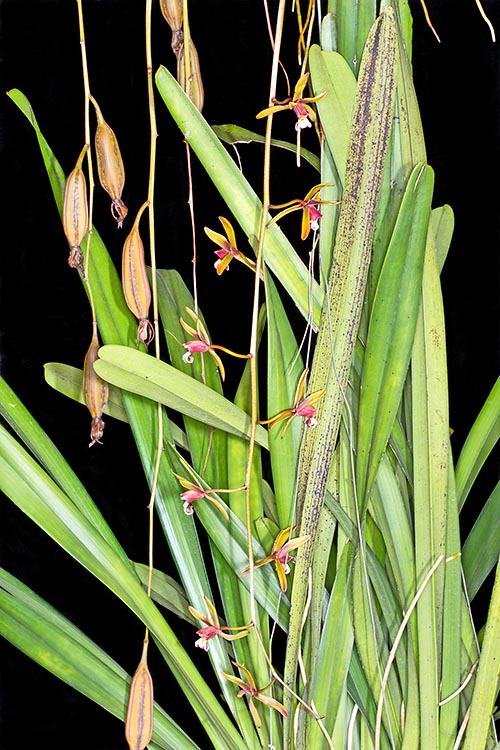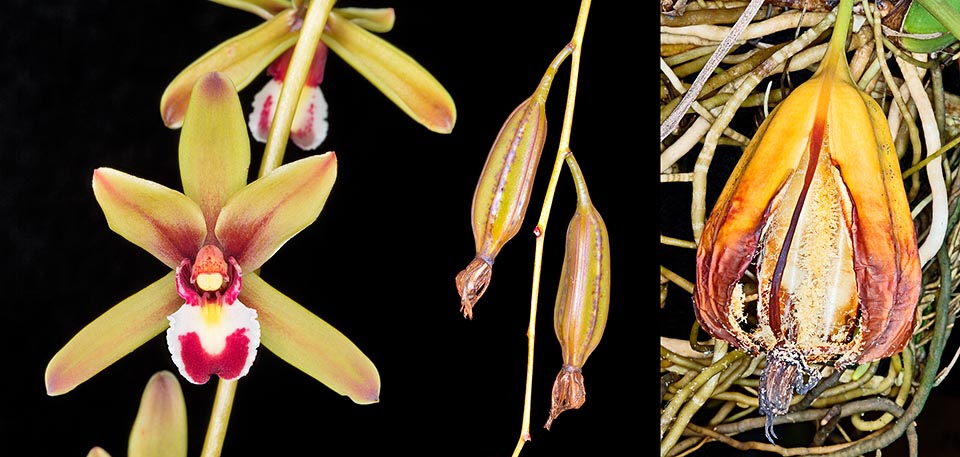Family : Orchidaceae

Text © Pietro Puccio

English translation by Mario Beltramini

Cymbidium finlaysonianum is an epiphyte or lithophyte, even 90 cm tall © G. Mazza
The name of the genus comes from the Greek “κυμβίδιον”, from “κύμβη” (cymbe) = pot, cup shaped like a small boat, with reference to the shape of the labellum; the species is honoured to the Scottish surgeon and naturalist George Finlayson (1790-1823).
Common names: kare karawn pakpet (Thai); kiếm tiên vũ, kiếm hoàng lan (Vietnamese).
The Cymbidium finlaysonianum Lindl. (1833) is an epiphytic or lithophytic herbaceous species, up to about 90 cm tall, forming dense and wide tufts with close conical to ovoid pseudobulbs covered by the foliar bases, up to 6 cm long and 3 cm broad, with 5-7 lanceolate leaves with bilobed apex, of 0,3-1 m of length and 2-4 cm broad, coriaceous, often rigid, of light green colour.
Racemose inflorescence hanging from the base of the pseudobulb, 0,3-1,3 m long, carrying numerous flowers of 5-6 cm of diameter, rather spaced between themselves. Oblong-linear, about 3 cm long and 0,8 cm broad, sepals and petals, of yellow greenish to bronzy with brown reddish shades colour, in particular at the base, trilobed labellum, 2 cm long and 1,4 cm broad, with pointed lateral lobes streaked of red and oblong median lobe, curved at the apex, white, with purple red band at the apex and yellow base with two red lamellae prolonging up to the centre of the labellum. The flowers, which emit a slight pleasant scent, last about two weeks and are usually pollinated by the bees.
It reproduces by seed, in vitro, micropropagation, but usually and easily by division, with each section provided of at least 3-4 pseudobulbs.
Species of remarkable ornamental value due to the long drooping inflorescences very diffused in nature as well as in parks and gardens of south-eastern Asia and which has originated numerous hybrids, cultivable in open air in the tropical and humid subtropical regions, placed, for instance, in cavities on the trees with the roots sinking in the vegetal debris accumulating there. It needs medium-high temperatures, 22-36 °C, and high atmospheric humidity, 75-90%, with good and constant ventilation, in these conditions, besides in spring-summer, may bloom again in other periods of the year.
Elsewhere, it may be cultivated in pot or in suspended baskets, seen the particular disposition of the inflorescences, provided with excellent drainage, utilizing a compost rich of humus or finely sliced bark fragments with addition of agri-perlite and charcoal fragments, to be placed in a particularly luminous location.

Close-up of the flower, the growing fruits and of a ripe, full of seeds, open fruit © Giuseppe Mazza
The species is inscribed in the appendix II of the CITES (species whose trade is internationally ruled).
Synonyms: Cymbidium wallichii Lindl. (1833); Cymbidium pendulum var. brevilabre Lindl. (1842); Cymbidium tricolor Miq. (1864).
→ For general notions about ORCHIDACEAE please click here.
